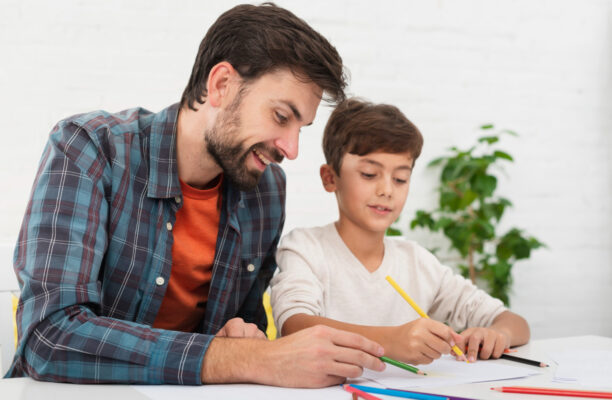Fostering responsibility, independence and a love of learning is key to school success. Learn how to support your kids’ education at home by encouraging them to take initiative, removing distractions and monitoring their homework and study habits.
Teachers use a variety of teaching strategies to help students learn. Some of these are especially helpful for kids who learn and think differently.
Create a Learning-Friendly Environment
Children spend many hours in school each day, so it’s important to provide them with an environment that supports learning. This involves removing distractions, creating a study area and monitoring their TV, video game and Internet use. It also means fostering an understanding that schoolwork is an important and worthwhile endeavor.
The physical learning environment is defined by classroom layout, furniture arrangement, materials available for use and visual cues. It can be improved by incorporating design elements that make the classroom feel home-like, such as neutral colors, soft furnishings and framed art. It also includes ensuring the classroom is tidy and safe, with clear pathways to exits in case of emergency and a designated homework space where children can focus without interruption.
Providing students with an emotional learning environment that supports their educational journey is another way to foster an effective learning environment. This includes establishing routines they can depend on, fostering positive peer relationships and respecting each student’s individual needs and feelings. It may include a class pet, jokes or traditions, and allowing students to share their passions with one another in order to build a sense of community.
Children are more likely to connect with and value their learning environment when they have a role in shaping it. For example, allowing students to pick out their own school supplies, decorate their workspace with photos and drawings and include their name on a sign communicates that the space is their own. It can also be helpful for teachers to involve their students in the process of creating their classroom environment through surveys, open discussions and events. This helps students feel connected to their learning environment and more willing to take responsibility for their own behavior and learning.
Remove Distractions
A distraction is anything that pulls a student’s attention away from the classroom learning experience. That may be as simple as listening to recorded audio lectures with background music while cleaning the house or texting friends while completing a math assignment online. Fortunately, there are many ways to help students overcome distracting temptations and stay focused on the task at hand.
Teachers can do a lot to reduce the number of distractions in the classroom, but they cannot prevent all of them. The biggest culprits are the electronic gadgets that students carry with them. While these devices offer a wide range of educational apps, they also provide access to social media and streaming services that can cause major distractions for students.
It’s not uncommon for students to fall into the trap of being distracted by a song or video on their social media app, even when they are listening to a lecture or reading an assigned chapter in a textbook. For example, a student might listen to their favorite pop song while studying and find themselves singing along, causing them to lose focus on the lesson at hand.
The good news is that parents can do a lot to help their kids remove digital distractions when they are studying or doing homework. They can encourage their kids to designate a study space and turn off all other apps so that they can work undistracted. They can also use parental controls on their kid’s smartphone or computer to restrict access to social media during studying time.
They can also model good behavior by putting down their own phones when they need to concentrate on other tasks, such as answering emails or making a grocery list. Rewarding students for demonstrating good discipline outside of class can also go a long way in improving their focus. For example, Top Score Writing CEO Lisa Collum suggests that parents create fun reward charts that recognize accomplishments like getting to class on time or helping with chores during lunch break.
Promote Independence
A major part of learning is discovering things by trial and error, so children need lots of opportunities to explore their interests. This can happen when they play, spend time with friends, play sports, act in a school play, visit museums and libraries and read on their own.
Providing children with opportunities to learn independence will help them feel confident and capable, which encourages them to take on challenges that will improve their skills. This can include asking them to think out loud about what they are learning and teaching them how to use resources around them. It also means providing them with age-appropriate tasks they can do independently such as putting on their own clothes, brushing their teeth, finding the right shoes and coat for going outside, packing a lunch, deciding what homework to do and so on.
In addition to removing distractions and providing children with opportunities to practice independent learning, you can help them develop their independence by showing them how to do things on their own and letting them get started on those tasks without intervention. For example, you can show them how to brush their teeth by letting them turn on the water, dip the toothbrush in and start brushing their teeth. It’s important to let them finish the task on their own so they can experience the sense of accomplishment.
You can also promote independence by creating a routine and schedule for your kids that includes times when they can work on tasks that require more focus and deliberation. This will give them a chance to anticipate what’s coming next and prepare themselves in advance. It’s also a good idea to establish a system for helping them when they need it and providing them with activities that can keep them busy while they wait.
Set Clear Learning Goals
In addition to clearly explaining their expectations for assignments, teachers should also help students set learning goals. These may be individual student-specific or family-specific. They can be written as statements of observable and measurable actions that students must be able to perform by the end of a course, week or lesson. They should align with the content, teaching, and evaluation strategies that teachers employ.
Investing in the process of learning is critical to kids’ performance at school and at home. When kids see adults modeling this, they learn that education and parenting are long-haul endeavors—that grades don’t come in on a daily basis. They also learn that failing and striving to be better are normal human experiences.
Parents can help kids set goals by encouraging them to write down their weekly and monthly homework assignments, as well as their time spent on reading, writing, studying for a test, and other academic activities. They can then review these goals at the beginning of a semester, month or year and use them to measure their progress. Having these concrete, tangible reminders of their progress can increase kids’ commitment to their goals and encourage them to take risks.
Children who are accustomed to working at a steady pace can benefit from external reminders of the passage of time—such as a clock on the wall or a kitchen or bathroom timer that gives audible cues when it’s time to return to schoolwork. These tools can also help kids set time limits for their screen use to ensure that they don’t get distracted or lose track of the amount of time they are spending on a video game, social media, or other non-academic activity.
Encourage Your Kids to Do Their Best
In order for kids to learn, they must do their best. This means focusing on behavioral expectations and providing them with a clear set of learning goals that they can work towards, rather than relying on punishments and rewards.
It’s also important for parents to encourage their children and provide them with the support they need to succeed. This includes helping them find the joy in the learning process, piqueing their curiosity about new subjects, and encouraging active learning. For example, letting them play with their favorite toys and exploring with them are great ways to help them develop their interests. Moreover, making sure they have the books and other materials they need to learn and grow is crucial.
Finally, avoiding constant criticisms and praising them for their successes can help foster a love for learning. This is especially important since a study found that praise has the same effect as positive feedback when it comes to improving performance.
In addition, don’t let your child stay home from school unless they are truly sick. Keeping them home too much can lead to them falling behind in their education, as well as preventing them from experiencing the real world and developing social-emotional skills they will need to navigate it successfully.
Finally, be sure to communicate with your child’s teachers and school, both when it comes to general classroom expectations and individual academic needs. This can help you stay informed about their progress, as well as prevent any miscommunications and confusion. Moreover, it’s a good idea to share your own experiences and tips for supporting your kids’ learning at home so that everyone is on the same page.


